
LOYALTY CODE:
The paper code cannot be redeemed when browsing in private/incognito mode. Please go to a normal browser window and enter the code there

LOYALTY CODE:
The paper code cannot be redeemed when browsing in private/incognito mode. Please go to a normal browser window and enter the code there
This content is copyright protected!
However, if you would like to share the information in this article, you may use the headline, summary and link below:
Title: USA: Still the land of opportunity?
Aidan Brennan reports from Michigan in the United States where he meets first generation farmers Paul and Brittany Windemuller.
https://www.farmersjournal.ie/usa-still-the-land-of-opportunity-843201

ENTER YOUR LOYALTY CODE:
The reader loyalty code gives you full access to the site from when you enter it until the following Wednesday at 9pm. Find your unique code on the back page of Irish Country Living every week.

CODE ACCEPTED

You have full access to farmersjournal.ie on this browser until 9pm next Wednesday. Thank you for buying the paper and using the code.

CODE NOT VALID
Please try again or contact us.
For assistance, call 01 4199525
or email subs@farmersjournal.ie
Sign in

Incorrect details
Please try again or reset password
If would like to speak to a member of
our team, please call us on 01-4199525
Reset
password
Please enter your email address and we
will send you a link to reset your password

If would like to speak to a member of
our team, please call us on 01-4199525
Link sent to
your email
address
![]()
We have sent an email to your address.
Please click on the link in this email to reset
your password. If you can't find it in your inbox,
please check your spam folder. If you can't
find the email, please call us on 01-4199525.
![]()
Email address
not recognised
There is no subscription associated with this email
address. To read our subscriber-only content.
please subscribe or use the reader loyalty code.
If would like to speak to a member of
our team, please call us on 01-4199525
 This is a subscriber-only article
This is a subscriber-only article
Update Success !

More often than not, when we hear about dairy farming in the United States we hear about mega dairy farms with thousands of cows. And while these farms may be increasing in prominence, the backbone of the US dairy sector remains the smaller-scale family farm model.
The Windemuller family from Coopersville in Michigan own one such family dairy farm. Not only that, but Paul and his wife Brittany are first generation dairy farmers, holding true to the saying that America is the land of opportunity.
While Paul is not from a dairy farm, he is from an agricultural background as his family ran an agricultural machinery dealership, so he grew up immersed in farming and worked on dairy farms while in school.
That planted the dairy farming seed for Paul and he went to study agriculture at Michigan State University, which included one semester spent at Lincoln University in New Zealand.
After graduating with his degree, he went back to New Zealand to work for a year on farms before Brittany and himself decided to return to the States with the goal of setting up their own dairy farm.
One year later in 2013, and with savings of $20,000 (€18,450), they put the down payment on a 13-acre farm with four old outbuildings and a dwelling house in Coopersville, a small town situated 20 minutes from Lake Michigan and 30 minutes from Grand Rapids city in central Michigan.
The land they bought wasn’t a dairy farm, but the couple recognised that it had potential for dairy conversion. The farm is located just a few miles outside Coopersville, in a rural and very much a farming area. The land here is good and productive, with corn and root-crops the main land-use.
It’s a strong dairy area and there are plenty of large dairy farms in the vicinity of the Windemuller farmstead.
With cash limited, Paul and Brittany came up with a plan to pay back the loan while at the same time to save money in order to invest in the dairy. The land was leased out to local farmers, as were some of the sheds while Paul and Brittany also kept some beef calves in another shed which helped with cashflow, all the while Paul was working off-farm to generate extra income.
In 2014, Paul had converted an old turkey coop on the farm to include a homemade milking parlour and freestyle barn for the cows. This was located in the old hip-roof barn, the quintessential American-style barn, but instead of being red and white, their building is black and white.
Leased cows
Thirty cows were leased from local farmers and the first load of milk left the farm in May 2014. Fast forward to today, and Paul and Brittany have grown the farm to 250 cows and have grown the family to six children.

The original 13 acres has been expanded to 15 acres, with Paul running a lean business. Almost all of the feed is purchased in from neighbouring farmers. There is little or no machinery on the farm, with just a skid steer used for cleaning sheds. The old milking parlour, which was expanded three times and ended up as a 10-unit milking 160 cows,was replaced by four Lely robots in 2017.
Paul became a full-time farmer in 2019, but still does some farm consultancy work on the side. Brittany is a stay-at-home mom and the six children are all home-schooled, so it’s a busy place. Cows are calving all year round with 200 cows milking at any one time.
Essentially what has happened over the last 10 years is that Paul managed to grow the business from 30 to 250 cows through free-cash and borrowings. In the initial years he says that the biggest obstacle was getting finance, so he had to prove himself to the banks in order to grow.

This meant that capital expenditure was low. Things were done as cheap as possible and he leveraged his own skills, work ethic and support network to get ahead when he couldn’t get financial leverage.
Borrowings
He says the first stage of borrowings (after the initial farm purchase) was for the new cow barn which was built in 2015 and then extended further in 2016.
This is a timber truss ‘A-roof’ structure with three rows of sand-bedded cubicles and a feed passage under the one roof. The robots and a farm office are located at one end of the barn.
The system is simple. All feed is purchased in and fed out by a local contractor on a flat rate payment system per head per day. This man has been working with the Windemullers since they started in dairying and Paul says the system is working well.
“The cows are fed a TMR (total mixed ration) using top of the range equipment. While I have to cover the cost of feeding them, I don’t have any fixed costs or capital tied up in machinery and I don’t have to spend the time feeding the stock. The only machine I have is a skid steer loader,” he says.
This lean approach to machinery and depreciating assets is clearly a lesson that he brought home from his time in New Zealand.
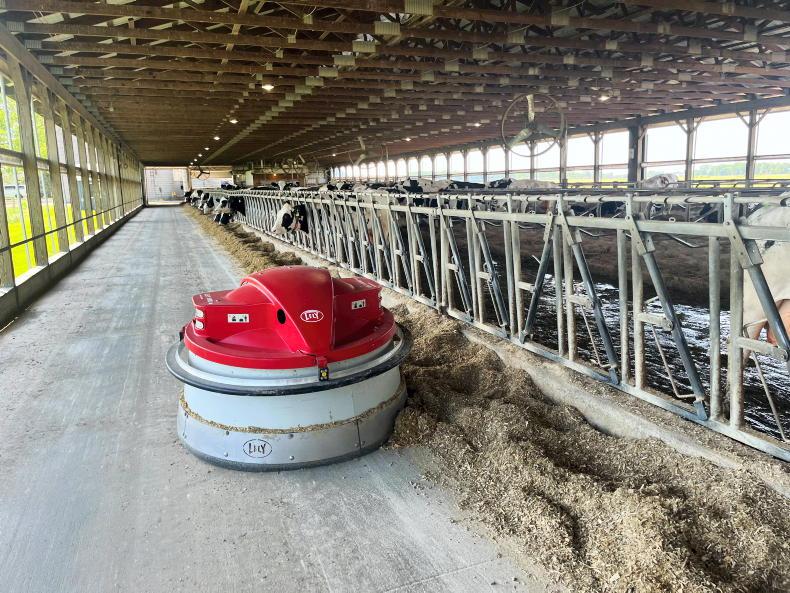
The TMR is pushed in a couple of times per day by an automated Lely feed pusher. On the robots, Paul says that they were cheaper to install than building a new milking parlour, finance was easier to get on them and they reduce labour input allowing him to work on the business as opposed to in the business.
There is one full-time employee on the farm, Abby Kiaunis, who has been working there since 2022. She too is from a non-farming background but started working on the farm on a part-time basis through a school outreach programme that Paul is involved with.
Abby and her boyfriend have also set up an animal genetics trading business, mostly embryo transfer and small scale Jersey heifer rearing, which they run from the Windemuller farmyard. Milk yield
Paul says the Holstein Friesian cows are producing around 44l per cow per day. The diet is about 55% forage, made up of 60% corn silage and 40% alfalfa. These forages are purchased from local farmers. All of the land around the yard is in pasture, and is used for grazing dry cows or young stock.
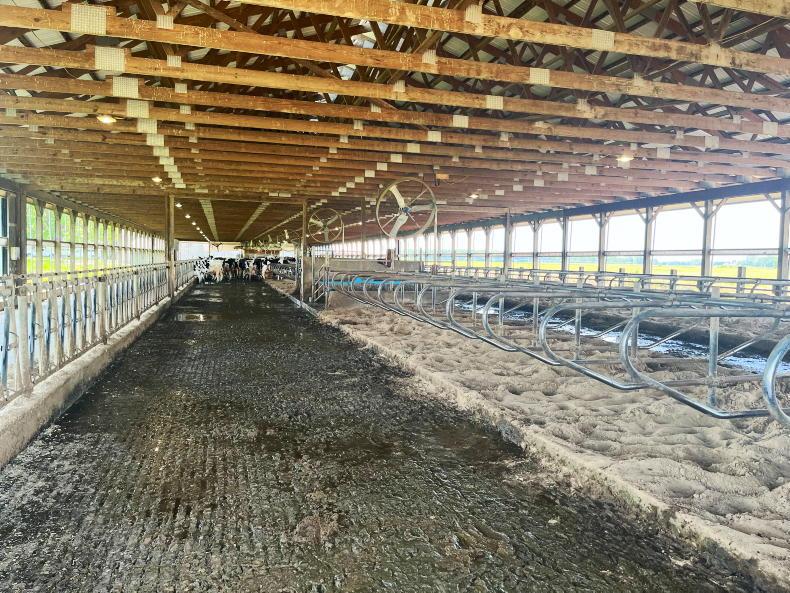
This system of buying in forages is common in the US and Paul says that prices are agreed based on yield and quality and the market price for corn as determined by the Chicago Board of Trade. He says that it is possible to forward-buy in advance of harvest.
The other 45% of the diet is made up of concentrates, including ground corn, soyabean meal, rapeseed meal, minerals and vitamins and buffers. He says that feed costs are $9/cow/day (€8.30/cow/day).
When the Irish Farmers Journal visited the Windemuller farm in May 2024, one of the big earners at that time was calf sales, with beef calves making over $800 (€740) at just a few days of age.
“We’re making between $3,000 and $4,000 (€2,768 and €3,680) per week in calf sales alone which is phenomenal money for calves just a few days of age. As a result we’re breeding everything to Angus at the moment. The calves get picked up every week and they go to an Amish farm in Ohio. They rear them to 400 to 500lbs liveweight in their first year before they are then sold on to a feedlot for finishing,” he says.

Cull cow prices have also increased and Paul says that one cull cow and a calf can now easily pay for the cost of a replacement heifer. Paul says that he has a good relationship with some of the larger farms locally, so can still get access to good genetics when purchasing in dairy replacements.
In terms of breeding, the herd has an average of 2.6 lactations in age, with the average lactation length of 380 days with 40 to 50 days dry. The average age of first calving for heifers is 22 to 23 months.
Sustainability
I asked Paul about the sustainability measures being adopted on his farm. He says that for him the most important part of sustainability is profitability – if the farm is not inherently profitable then it is not sustainable.
He adds that sustainability is about more than just the farm or the farm family, it’s also about the community and the people that work on the farm and then the environment.
In terms of what he is doing to protect or improve the environment, he says that most of his pastures are old permanent pastures with up to 20 species – this is used for grazing dry cows and doesn’t get any synthetic fertilisers.
He is planning to install solar panels on the roof of the cow shed to lower the farm’s greenhouse gas footprint. He says that during the summer months the solar will power between 90% and 95% of the farm’s electricity requirement, but that this drops to 30% in the winter months.

Paul has been able to secure a 50% grant for this investment through his co-op, Dairy Farmers of America (DFA).
He says that DFA are involved in stimulating sustainable investments on farms. They also provide interest free loans for plate coolers and bulk tanks on farms. He adds that the farm is also reusing water.
Methane reduction and anaerobic digestion
The two other technologies that Paul mentions are methane reducing feed additives and anaerobic digestion (AD). On feed additives, he says that it is an option, but that the sector needs to decide who’s going to pay for it as it’s not cheap.
On AD, Paul took us on a tour of the locality and we passed a few large farms that have recently invested in AD. Paul says that the absolute minimum number of cows needed to make AD viable is 6,000 cows in one unit.
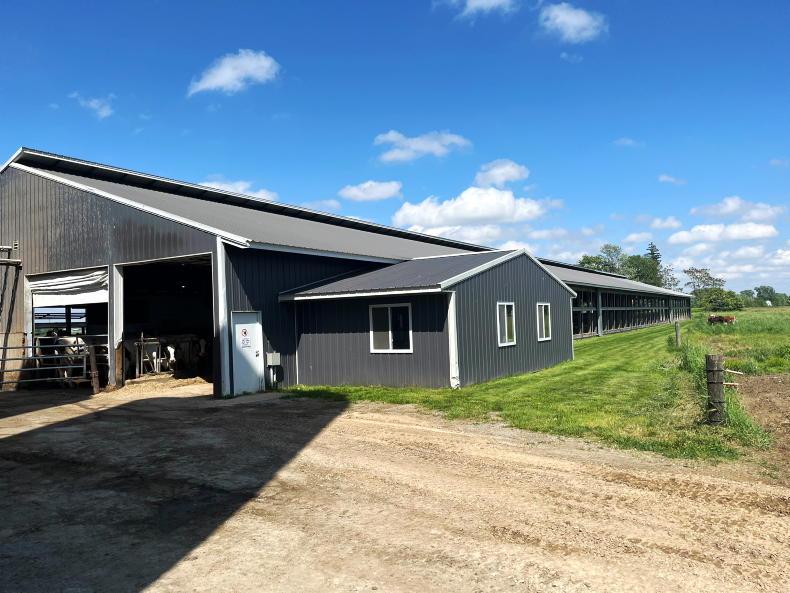
Around the Coopersville area, all of the AD plants have scrubbers which allow the biogas to be cleaned before being compressed and pumped directly into the gas grid.
With investment costs in the tens of millions, Paul doesn’t think it’ll ever be a runner for smaller farmers like him, but that it’s a real option for larger farmers to generate extra income from dairying, while also reducing their carbon footprint and potentially selling the carbon credits.
One of the other benefits is that farms with AD plants tend to switch to green bedding or dried manure bedding as the waste heat from the AD plant is used to heat treat and dry the slurry, making it suitable as cubicle bedding material.
As it stands, Paul’s slurry is being spread on neighbouring farmers’ land through a splash plate and tanker.
This is mostly spread on grassland that is cut for hay. The slurry produced on the farm is stored in an earth-lined lagoon at the back of the cow barn.
This store is emptied every second month and Paul says that because of his small scale, he has very little involvement with the local authorities on a regulatory basis.
He says that in the US, if you have a concentrated animal feeding operation (CAFO) over 700 dairy cows, then there are more stringent rules and inspections.
When we visited the Windemullers in May, the farm was only just coming out of a bad experience with Bird flu (avian influenza). He says that 25% of the herd had to be treated and that sick cows took a huge drop in performance, reducing milk yield from 180lbs of milk per day to just 20lbs (81kg to 9kg).
The milk yield from the farm was running 10% behind the same time last year and he said that even though the cows that were infected had recovered, the impact on yield remained with the impacted cows producing 25% less than expected.
Community
The success achieved by Paul and Brittany in such a small time is remarkable. The pair have not only established a home for themselves and their large family, but they are contributing to their community through Paul’s involvement in local initiatives whether through school programmes or helping Abby get established.
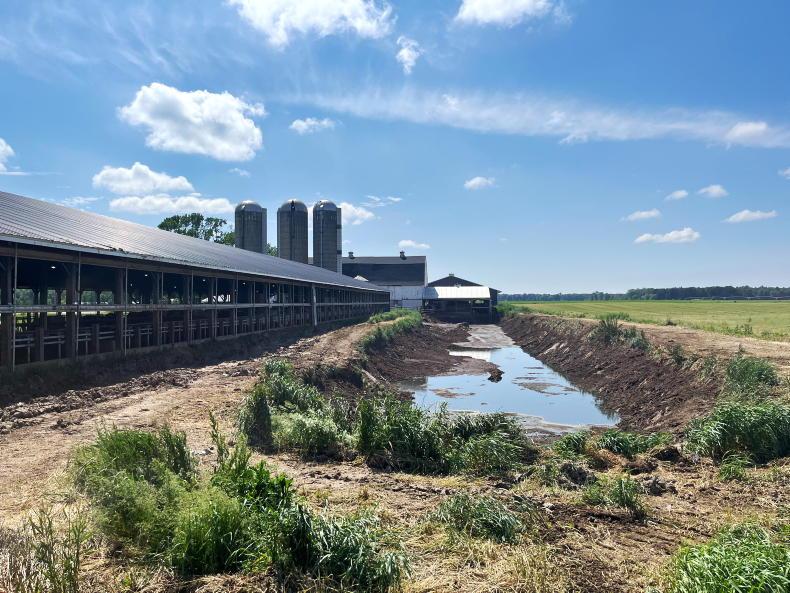
He is one of the first Nuffield scholars to come from the US and so is well travelled, but he freely shares that knowledge he has built up, both from his travels and his experiences as a first-generation dairy farmer.
It shows that the American dream is still attainable for those that want to achieve it.
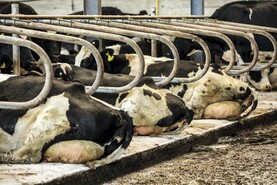


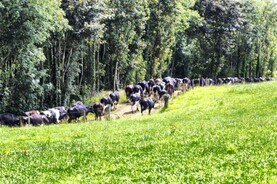
SHARING OPTIONS: